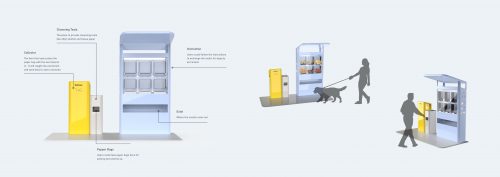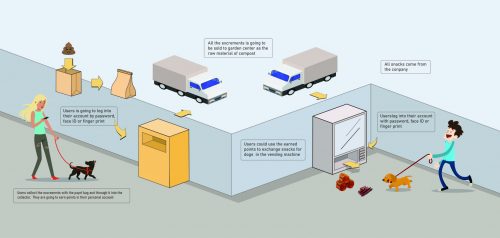Product Name: DeEstaw
Topic/problem description:
In modern cities, animals, especially companion animals, have become an integral part of the ecosystem of the urban area. According to the U.S pet ownership statistics provided by American Veterinary Medical Association, 2017-2018 U.S. Pet Ownership & Demographics Sourcebook, more than 125 million people have companion animals. Dogs comprise 38.4%—48 million— U.S. households. Each household owns an average of 1.6 dogs. The data from the China Small Animal Protection Association shows the number of pet cats and dogs in China reached 99.15 million in 2019, 55.05 million pet dogs, and 44.12 million pet cats. (Shan, X. 2019) The increase in total pet dogs and cats from 2018 is 8.4%. The number of pet owners in China reached 61.2 million, an increase of 8.36% from the last year.
The conflict between Pets, pet owners and other citizens is the main problem of keeping pets in Chinese large urban areas. Noise, environmental sanitation, living conditions, safety and health are hot topics that people care about, which ordinarily mentioned and communicated on various media platforms. Health awareness, safety, and unpleasant cleaning problems are three top topics that people disused.
People are curious about two major topics which is whether the dog is healthy, and under the control of the owner. Some pet owners could not schedule the vaccine and parasite expelling completely or at the right period, they need a professional guideline which is clear and easily to be understood.
Some dog owners refuse to collect the excrement of their dogs in public space, that leave upleasing cleaning problems in the communities. It also causes complaints and biases to all dogs and owners in the communities as troublemakers and less ethics.
Those conflicts and complaints cause bias and stereotypes to pet and pet owners, that pets bring illness, and troubles to the communities. Some citizens are not friendly, or even disgusted with pets or hurt them..
With these factors in mind, How might we support more dog-friendly communities, where people are more friendly to dogs walking on the street and owners feel more free and secure about walking their dogs.
Design Statement
How might we support more dog-friendly communities, where people are more friendly to dogs walking on the street and owners feel more free and secure about walking their dogs.
Solution:
A special service provided for users that a pet food company set special stations which separate into two functional parts, a vending machine and an excrement collector. The station would also contain a part providing paper bags for users to collect pet excrements; and cleaning tools like ethyl alcohol and tissue paper.Users could exchange the snacks for dogs with the vending machine by the pet excrements they collected. The company is going to put the snacks produced by their brand in the vending machine for exchanging to encourage pet owners to collect their pets’ excrement rather than leaving the waste on the grass or on the street. Users will have a personal account which would be on a smartphone application or WeChat mini program for the information location of machines and the pet food company.
The company would be the service provider who purchase the
facilities, provide the snacks, and run the system. Since the government or a Non-Profit Organization could hardly afford the cost, transfer the system into a commercial project, that the company is going to provide the service for users, but at the same time, the company would advertise their product, the snack, by placing these snacks into vending machines.
It would also be a great chance to increase the reputation of the company, and at the same time, users could get the free service.
References
U.S. pet ownership statistics. (n.d.). Retrieved October 23, 2020, from https://www.avma.org/resources-tools/reports-statistics/us-pet-ownership-statistics
The number of pets in China continues to grow in 2020, staple food consumption accounts for the largest proportion. (2020, March 17). Retrieved September 19, 2020, from http://jingzheng.chinabaogao.com/nonglinmuyu/031JT0222020.html
2018 status of China’s pet industry_Population. (2018, November 01). Retrieved November 12, 2020, from https://www.sohu.com/a/272608499_99970648
Shan, X. (2019, December 12). In 2018, the number of pets in China continued to increase, and market consumption continued to upgrade. In 2020, the pet market will usher in a new round of outbreak. Retrieved from http://www.ce.cn/xwzx/shgj/gdxw/201912/12/t20191212_33840887.shtml








